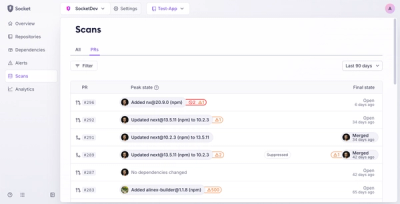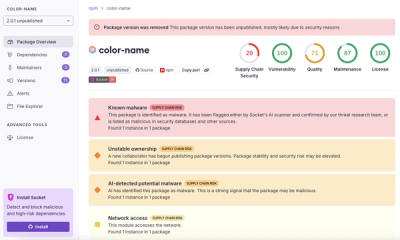
Product
Introducing Pull Request Stories to Help Security Teams Track Supply Chain Risks
Socket’s new Pull Request Stories give security teams clear visibility into dependency risks and outcomes across scanned pull requests.
Modular serialisation and management package for handling the running of functions on remote machines
Based off of the BigDFT RemoteRunner concept, remotemanager represents an improvement and expansion on the concepts based there.
Primary usage is via a Dataset, which connects to a remote machine via URL
You can think of the Dataset as a "container" of sorts for a calculation, to which "runs" are attached. These runs are then executed on the remote machine described by the provided URL
A quick install of the latest stable release can be done via pip install remotemanager
For development, you can clone this repo and install via cd remotemanager && pip install -e .[dev]
Tip: You can clone a specific branch with git clone -b devel.
If you want to build the docs locally a pandoc install is required.
You can install all required python packages with the [dev] or [docs] optionals.
Remotemanager exists to facilitate running on High Performance Compute machines (supercomputers). Script generation is ideally done via the BaseComputer module.
Existing Computers can be found at this repository. For creating a new machine class, see the documentation.
See the documentation for further information, tutorials and api documentation.
This section will run through running a very basic function on a machine.
It roughly echoes the quickstart page found in the docs.
Start by defining your "calculation" as a python function.
def multiply(a, b):
import time
time.sleep(1)
return a * b
We need to be able to connect to a remote machine to run this function.
Assuming you can connect to a machine with a string like ssh user@host or just ssh machine, you can directly create
a connection.
Use the URL module for this.
from remotemanager import URL
connection = URL("ssh@machine")
You can execute commands on this machine using the cmd method:
connection.cmd("pwd")
>> > "/home/user"
To execute your function on the specified machine, create a Dataset
from remotemanager import Dataset
ds = Dataset(function=multiply, url=connection, name="test")
You can specify the inputs that your function should use by adding Runner instances to the Dataset
ds.append_run({"a": 10, "b": 7})
Now run your Dataset with run().
You can wait for completion with wait()
ds.run()
ds.wait(1, 10)
Here, we are waiting for a maximum of 10s, and checking for results every 1s
Result collection is done in two stages.
Once a run is complete, we must first fetch the results with fetch_results.
Then we can access the results at the results property
ds.fetch_results()
ds.results
>> > [70]
The sanzu functionality allows you to tag a jupyter cell for remote running.
The cell will be converted into a function, set off to the specified remote machine, and executed there.
For detailed information, see the relevant section of the docs
To use this functionality, first enable the magic:
%load_ext
remotemanager
You should then create a URL instance for your machine:
from remotemanager import URL
connection = URL(...)
And now we can execute any cell on this machine by using the %%sanzu protocol:
%%sanzu
url = connection
%%sargs
a = 10
%%sargs
b = 7
a * b
>> > 70
This can be useful for doing file operations on the remote machine, however it is possible to access your results.
A sanzu run will inject a magic_dataset object into the jupyter runtime.
This is the Dataset that was used to execute the most recent cell, so you can access the information from there.
For our last run, we can see our results here:
print(magic_dataset.results)
>> > [70]
FAQs
remote run management tool
We found that remotemanager demonstrated a healthy version release cadence and project activity because the last version was released less than a year ago. It has 3 open source maintainers collaborating on the project.
Did you know?

Socket for GitHub automatically highlights issues in each pull request and monitors the health of all your open source dependencies. Discover the contents of your packages and block harmful activity before you install or update your dependencies.

Product
Socket’s new Pull Request Stories give security teams clear visibility into dependency risks and outcomes across scanned pull requests.

Research
/Security News
npm author Qix’s account was compromised, with malicious versions of popular packages like chalk-template, color-convert, and strip-ansi published.

Research
Four npm packages disguised as cryptographic tools steal developer credentials and send them to attacker-controlled Telegram infrastructure.